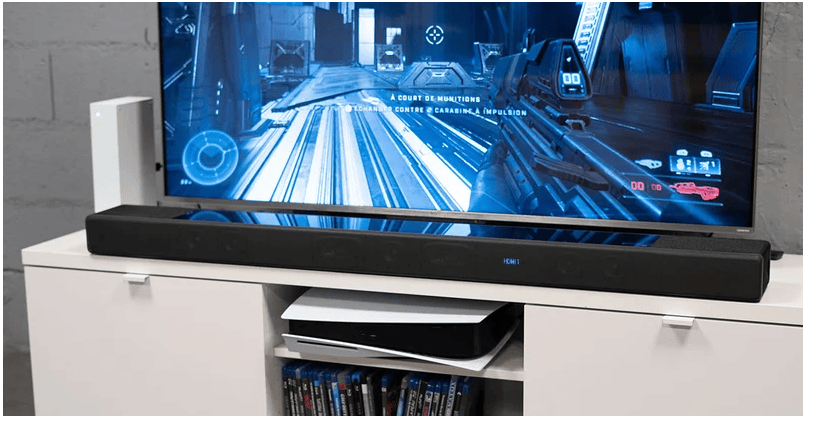Sony HT-A7000
With the HT-A7000, Sony reinvests the segment of high-end Dolby Atmos/DTS:X sound bars, which it had somewhat abandoned in recent years. And it's a great return for the Japanese manufacturer.
Presentation
The HT-A7000 is Sony's new flagship soundbar. It replaces the HT-ST5000, which was released more than four years ago and is now enjoying a well-deserved retirement after its unusually long commercial career.
In line with what is now the bare minimum for a premium soundbar in 2021, the HT-A7000 obviously intends to offer three-dimensional virtual spatialization thanks to its Dolby Atmos and DTS:X compatibility - but not only. It also presents itself as one of the first sound bars to support 360 Reality Audio, an immersive audio format dedicated specifically to music, designed and promoted by Sony itself. A strong argument for subscribers to Deezer Premium, Tidal and Amazon Music Unlimited, the three main streaming services offering music mixed in this format.
Manufacturing
At first sight, the HT-A7000 immediately reveals its Japanese identity. Like many other products from Sony, Yamaha or other Japanese manufacturers, it has an all-black design, but a somewhat convoluted design, not quite all-encompassing... and a taste for shiny black plastic.
The top of the bar, which is almost entirely covered with it, will inevitably become full of fingerprints and other micro-scratches - especially on its touch controls. Even more annoying, the high reflectance of this surface is a source of great visual distraction when the bar is placed right in front of a TV. This fault of taste is all the more frustrating since, apart from that, the HT-A7000 benefits from an exemplary assembly quality.
With a 1.3m span, the HT-A7000 occupies the same width as a 65" TV, so be sure to have a large enough cabinet to accommodate it. As for its thickness, it is 8 cm, which can often require a slight elevation of the TV set to prevent it from hiding the bottom of the screen.
Connectivity
The HT-A7000 has two HDMI inputs and one output, the latter being eARC compatible. All these HDMI interfaces have the particularity, still very rare on the current sound bars, to allow the transmission of video signals at HDMI 2.1 rates. Gamers, in particular, can therefore connect their PS5 and/or their Xbox Series X/S while keeping the possibility of a 4K video stream at 120 Hz with HDR10 or Dolby Vision. The only exception: the bar is currently unable to accept signals with Variable Refresh Rate (VRR). We'll give ourselves permission to hope that a future firmware update can change that - probably not until VRR first appears on the PS5 and the manufacturer's TVs, though.
As far as decoded audio formats go, the HT-A7000 basically ticks all the boxes: it swallows all existing Dolby and DTS formats without a hitch (with the exception of Dolby AC4, which is hardly used anywhere at the moment), as well as LPCM up to 7.1. One could not really ask for more.

User experience
When it comes to its user experience, the HT-A7000 blithely mixes excellence and frustration. As is often the case with Sony, the HT-A7000 indulges in a complexity, a proliferation of features and settings of varying interest, in which it is very easy to get lost. This is perfectly symbolized by its remote control, which includes no less than 37 buttons! Was this really necessary?
At the same time, however, the HT-A7000 offers a luxury that is far too rare for sound bars of its type: a very complete and responsive TV interface. Rather than being confined to the small display on the front of the bar, its menus and other information can be displayed directly on the TV - sometimes full screen, sometimes overlaid on the content when using video pass-through on the HDMI inputs. So, at least it's easy to navigate through the above-mentioned abundant setting options.
It should also be noted that the bar can be controlled using Amazon Alexa or Google Assistant voice assistants. However, it does not integrate these assistants itself; you have to use an external smart speaker, such as Amazon Echo or Nest Audio, to access voice control.
Connected features
Sony made the wise choice not to use any proprietary streaming ecosystem: the bar simply supports Chromecast, Alexacast, AirPlay 2 and Spotify Connect. That's enough for it to be compatible with virtually all existing streaming services, regardless of the playback device used.
In fact, it is precisely through Chromecast or Alexacast that the bar interconnects with Deezer, Tidal and Amazon Music for 360 Reality Audio compatibility.

Audio
The equipment of the HT-A7000 is not at all pared down. No less than 11 channels of amplification, "X Balanced" woofers (a principle of optimization of the size of the membranes already used by Sony on the excellent SRS-XBx3 portable speakers), lateral tweeters with beam-forming waveguides, two full-range speakers oriented towards the ceiling, all this working in concert with a wide use of acoustic phase matching techniques for the creation of Virtual Surround effects... Sony's engineers seem to have made it a point to use absolutely every technique at their disposal to generate the widest and most immersive sound possible.
And the result is extremely convincing. Even before starting to talk about virtual spatialization, the HT-A7000 impresses by the clarity and balance of its "pure" reproduction. Even though the extreme high frequencies (above 11 kHz) are emphasized to accentuate the sensation of liveliness of the sound, the latter never takes the aggressive turn that home-cinema oriented products often suffer from, because they are more concerned with the spectacular than with the accuracy of their sound - see, for example, the HT-ZF9 sound bar from Sony... On the contrary, the HT-A7000 shows, if it were really necessary, that these two values are not at all antinomic.
Because this balance is associated with a very satisfactory precision and richness of detail. However, it must be said that the HT-A7000 does not equal the references of the genre on these metrics; we think in particular of the HW-Q900A of Samsung. The match is certainly not fair since we are comparing bars without and with dedicated subwoofer. But in absolute terms, it is clear that although the bass channels integrated directly on the Sony bar do a very good job, they remain constrained by immutable physical limits. The presence of very low frequencies in the sound message is assured at the cost of a low midrange that lacks a little punch; the reactivity on the transients of extinction in particular is relatively weak, and compromises the physical impact of certain effects. Moreover, some resonances in the vents can be heard at times, and lead to a slight uniformity of timbres. This gives the impression of a very slightly hazy bass, lacking in depth. Absolutely nothing dishonorable, but still a little frustration for the ear. This is the limit of the exercise of the premium sound bar without a separate cabinet.
Apart from that, everything else is of high quality, of impeccable transparency. One can note in particular the bluffing sensation of presence of the voices - that it is about the sung voices in musical listening, or about the dialogues in the films.
But in truth it is with this famous virtual spatialization that we will finally bring to light the main talent of the Sony soundbar. The 7.1.2 sound created is quite breathtaking, insofar as it manages not only to be very enveloping, but also to build a very clear differentiation between the different surround channels. The soundstage is very vast and gives a real impression of three-dimensionality, thanks to a surprisingly credible materialization of the point sources - this last point being extremely rare with virtual spatialization solutions. It is still a long way from what a "real" multichannel installation would do, but the HT-A7000 is well above what the common Dolby Atmos/DTS:X sound bars do.
It is helped in this by its automatic acoustic calibration function, which is done in just a few seconds during the initial configuration, via a microphone integrated directly into the bar. This calibration is very efficient and allows it to produce a spatialization that works just as well in very matt acoustics as in very reverberant rooms - within reason, of course, for the latter.
Let's make two important points before concluding. Firstly, the bar includes a function for upmixing stereo, 5.1 and 7.1 sources into 3D audio, called "Immersive Audio Enhancement". This function must be left deactivated for stereo sources: its overly aggressive approach distorts the timbres and gives the impression of listening to music in a glass jar; it is much better to remain in simple front stereo, which already has more than enough stage width. On 5.1/7.1 sources, the upmix is much better, but remains of very questionable use: it only adds a little artificial reverberation on the high channels, without any real gain in immersion.
Finally, the bar offers three virtual spatialization modes, named "standard", "music" and "cinema". The first is the most versatile mode, giving the most neutral rendering. The music mode, on the other hand, simply deactivates the spatialization, and restricts the signal to a 3.1 using only the front channels, including for Dolby Atmos and DTS:X sources. We don't really understand the point of this. As for the cinema mode, it uses the same spatialization treatments as the standard mode, but adds a very slight "V" equalization to the signal (bass and treble accentuation). This reinforces the sense of directionality of the sounds, since it is mainly thanks to the high frequencies that the human auditory system perceives this directionality. The effect is quite relevant; it is up to each person to try it out and see if they are receptive to it.
Conclusion
Sony has spared no expense in making the HT-A7000 a serious contender for the title of absolute reference in the Dolby Atmos/DTS:X soundbar market (with the exception of the Sennheiser Ambeo Soundbar, which is out of the competition). It impresses in particular by the breathtaking quality of its virtual spatialization, incredibly immersive - and this whatever the acoustic characteristics of the listening room. On the other hand, one can find a little better in terms of dynamics and pure explosiveness of the sound rendering, notably on the side of the HW-Q900A of Samsung. It's up to each person to determine where they place their priorities.




